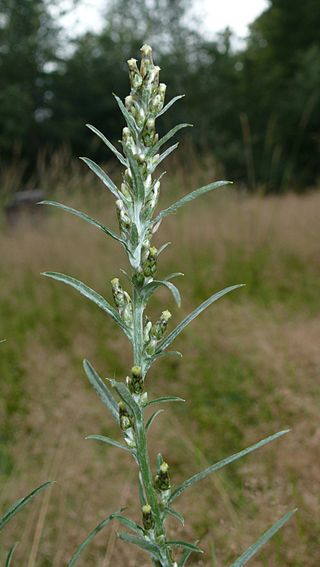
Allium validum is a species of flowering plant commonly called swamp onion, wild onion, Pacific onion, or Pacific mountain onion. It is native to the Cascade Range, to the Sierra Nevada, the Rocky Mountains, and other high-elevation regions in California, Oregon, Washington, Nevada, Idaho and British Columbia. It is a perennial herb and grows in swampy meadows at medium and high elevations.

Galium triflorum is a herbaceous plant of the family Rubiaceae. It is widespread in northern Europe, eastern Asia and North America. The plant is considered a noxious weed in New York, Pennsylvania, Vermont, New Hampshire, Connecticut and Massachusetts.

Allium cernuum, known as nodding onion or lady's leek, is a perennial plant in the genus Allium. It grows in open areas in North America.

Astragalus lemmonii, the Lemmon's milkvetch, is a rare plant of eastern California. It is a member of the bean family, the Leguminosae, and specifically a member of the subfamily Papilionoideae. The genus Astragalus is a large genus within this family; members of this genus are known as milkvetches or locoweeds. Close relatives of this particular species include Astragalus peckii and Astragalus lentiformis.

Cordylanthus capitatus, the Yakima bird's-beak or clustered bird's-beak, is an uncommon plant of the Western U.S.

Allium textile is a common species of wild onion found in the central part of North America.

Allium acuminatum, also known as the tapertip onion or Hooker's onion, is a species in the genus Allium native to North America.

Allium atrorubens is a species of wild onion known by the common name dark red onion. This plant is native to the southwestern United States where it grows in the sandy soils of the Mojave Desert, the Great Basin and higher-elevation deserts in Nevada, eastern California southwestern Utah, northwestern Arizona.

Galium multiflorum is a species of flowering plant in the coffee family known by the common names Kellogg's bedstraw, shrubby bedstraw, and many-flowered bedstraw. It is a perennial herb that grows on rocky soils, mountains, and desert slopes.

Gnaphalium palustre, known by the common name western marsh cudweed, is a species of flowering plant in the family Asteraceae.

Goodyera oblongifolia is a species of orchid known by the common names western rattlesnake plantain and giant rattlesnake plantain. It is native to much of North America, particularly in the mountains of the western United States and Canada, from Alaska to northern Mexico, as well as in the Great Lakes region, Maine, Quebec and the Canadian Maritime Provinces.
Allium punctum is a species of wild onion known by the common name dotted onion or Modoc onion. It is native to the western United States in and around the Modoc Plateau in northeastern California, northwestern Nevada, and southeastern Oregon. It is uncommon, growing in volcanic flatlands created by old lava flows.

Euchiton sphaericus, the star cudweed or tropical creeping cudweed, is a herb native to Australia, New Zealand, New Caledonia, Taiwan, Java, and Philippines. It has become naturalized in a few places in the United States.

Omalotheca sylvatica, synonyms including Gnaphalium sylvaticum, is a species of plant in the family Asteraceae. It is commonly known as heath cudweed, wood cudweed, golden motherwort, chafeweed, owl's crown, and woodland arctic cudweed. It is widespread across the temperate Northern Hemisphere, throughout North America and Eurasia. The species was first formally described by Carl Linnaeus in 1753 as Gnaphalium sylvaticum.
Caulanthus barnebyi, the Black Rock wild cabbage, is a plant species endemic to a small region in the US State of Nevada. It is known only from the Black Rock Mountains in Humboldt and Pershing Counties in the northwestern part of the state. It grows on dry, rocky slopes and outcrops at elevations of 4,300–4,900 feet (1,300–1,500 m).
Descurainia paradisa is a plant species native to eastern and northern California, southeastern Oregon, Box Elder County in northwestern Utah, and most of Nevada. It grows in shrub communities at elevations of 3,300–7,500 feet (1,000–2,300 m).
Thelypodium laxiflorum, the droopflower thelypody, is a plant species native to the southwestern United States. It grows in open, rocky places on slopes and cliff faces, usually in pinyon-juniper woodlands at elevations of 4,900–10,200 feet (1,500–3,100 m). It has been reported from Utah, western Colorado, southern Nevada, northwestern Arizona, and northwestern New Mexico.

Allium macropetalum, the desert onion, is a species of wild onion native to the desert regions of southwestern United States and northwestern Mexico. It is known from desert plains and hills in Sonora, Arizona, Utah, Colorado, New Mexico, and Texas, at elevations up to 2500 m.

Allium simillimum, the Simil Onion, or dwarf onion, is a plant species native to Idaho and Montana. It grows on sandy soils at high elevations in the mountains, 1800–3400 m.

Gnaphalium polycaulon, the many stem cudweed, is a plant species in the family Asteraceae. It is widespread across much of Mesoamerica, South America, and the West Indies, and naturalized in parts of Asia and Africa.
















